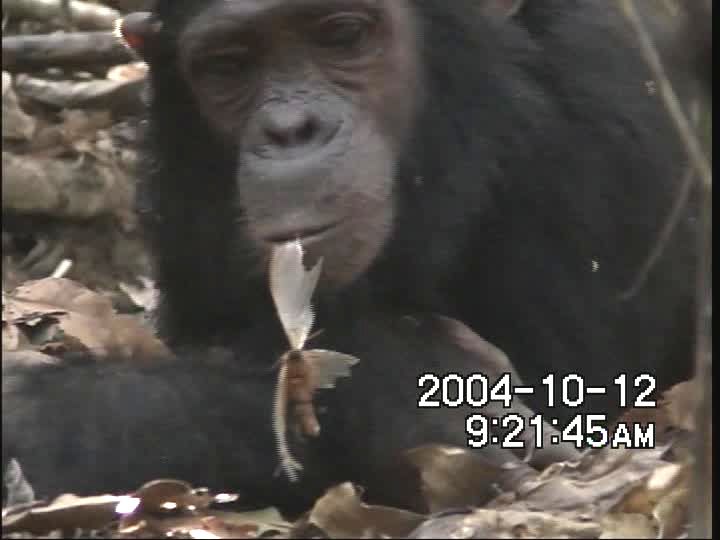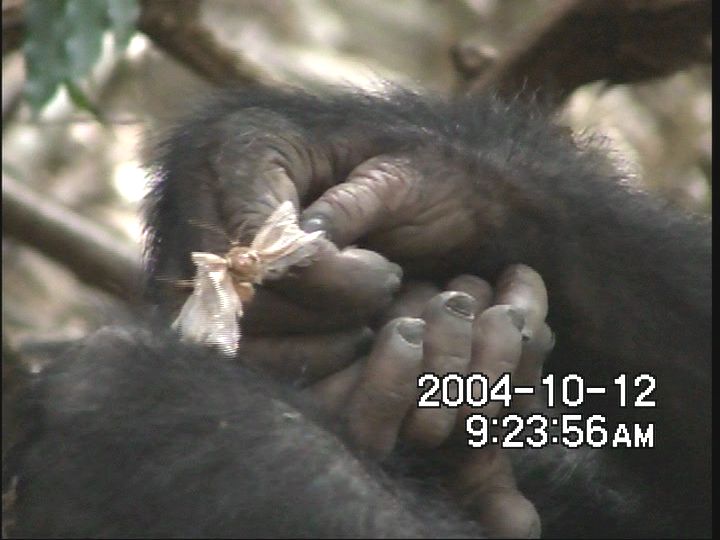|
<NOTE>
A Juvenile Chimpanzee Played with a Live Moth
Michio Nakamura
Wildlife Research Center, Kyoto University, Japan INTRODUCTION Although it is not common for chimpanzees (Pan troglodytes) to capture and toy with small mammals or birds without eating them, several reports have indicated that this does sometimes occur (e.g., Hirata et al. 2001; Zamma 2002; Carvalho et al. 2010). These reports compared such incidents with chimpanzees' hunting behaviors because it seems puzzling that the chimpanzees did not eat the meat. However, it is possible that a chimpanzee may show an interest in a living organism for its animacy per se, with no intention of eating it. This paper reports the case of a juvenile female chimpanzee at Mahale that captured and played with a live moth (Lepidoptera). Although chimpanzees frequently prey on several insect species (mostly social insects) (e.g., McGrew 1992; Fuse 2013), Mahale chimpanzees eat moths only rarely (Nishida & Uehara 1983). OBSERVATION The observation focused on chimpanzees in the M group at the Mahale Mountains National Park (see Nishida 2012 for details of the study site). At 09:19 a.m. on 12 October 2004, two adult female chimpanzees and their offspring had been taking a rest under a dense bush since 08:54. a.m when Ichiro (IH: a 1-year-old male) emitted a slight huu call and was observed to be watching something on the ground. When IH touched the object with his finger, it moved, and I could then see that it was a large moth, about 5–6 cm in size and beige in color. Its body was thick, and its forewings were much longer than its hindwings. IH's mother, Ikocha (IK), immediately approached him, put him on her belly, moved away, and sat about 1 m away from the moth. Soon, IH's older sister, Imani (IM: a 6-year-old female), went to where the moth lay and started to investigate it. Because my initial view was largely obstructed by dense bush, I moved to the side to gain a better view and started to take a video. IM captured the moth without killing it and started to play with it, sometimes vigorously, sometimes calmly. Given her occasional play face and play pant, IM's series of behaviors was regarded as playful. I summarize the behavioral patterns observed during IM's play in Table 1 (see Video 1). The moth sometimes fluttered its wings while being pinched between IM's fingers or lips. Although IM frequently put the moth in her lips or touched it with her lip, she did not try to eat it. While IM was playing with the moth, IH approached her twice, and she responded playfully to him. At 09:25, IM put the moth in her groin pocket and slowly walked away into the bush; at 09:26, I lost sight of her because I could go no further into the bush. When she was observed again 4 min later, she no longer had the moth. Video 1.
DISCUSSION Unfortunately, I could not collect the moth or identify the species. However, from its appearance and size, I suspect that it was probably a hawk moth (family Sphingidae). Although Nishida & Uehara (1983) listed unidentified moths (larvae and imagoes) in the food list of Mahale chimpanzees, with no description as to how they ate them, IM's behaviors described here did not look like a feeding attempt. The total observation time during which IH and IM showed interest in and interacted with the moth was only about 7 min, but there were some similarities between their behaviors and chimpanzees' play with small vertebrates. For example, as Zamma (2002) reported in a case of a chimpanzee playing with a live squirrel, it seemed that IM too was enjoying the response of the moth, which sometimes fluttered. When the moth was motionless, she sometimes put her lower lip on it as if she were trying to activate the moth's movement again. She was careful enough in her handling of the moth not to flatten it, but because she finally tore off a part of a wing, it is difficult to say that she had no intention of killing the moth. Unfortunately, I did not observe what finally happened to the moth, but since the moth had already become weak, I suspect that it soon became inactive, and thus IM might have lost interest and abandoned it. This differs from former observations of mammalian and avian play toys, in which the interest of the chimpanzees was maintained for much longer, and they sometimes groomed or treated the animals like dolls even after the animals were dead (Hirata et al. 2001; Zamma 2002; Carvalho et al. 2010). Such differences may be due to differences in the sizes and shapes of the target animals. Interestingly, although it was the infant, IH, who first showed interest in the moth, his mother immediately took him away from the insect. Some insects are poisonous or spiny, so the mother may have been protecting her young son from such potential dangers. It is common for human children to capture, play with, and sometimes kill still-living insects with no apparent purpose. It is possible that both humans and chimpanzees, especially youngsters, share a common inclination to become interested in, and sometimes enjoy playing with, an animate object. ACKNOWLEDGEMENTS I thank COSTECH, TAWIRI, and TANAPA for their permission to conduct long-term research at Mahale. The study was supported by Kakenhi (#19255008, #19107007, and #21770262). REFERENCES Carvalho S, Yamanashi Y, Yamakoshi G, Matsuzawa T 2010. Bird in the hand: Bossou chimpanzees (Pan troglodytes) capture West African wood-owls (Ciccaba woodfordi) but not to eat. Pan Afr News 17:6–9.
Fuse M 2013. Chimpanzees detect ant–inhabited dead branches and stems: a study of the utilization of plant–ant relationships in the Mahale Mountains, Tanzania. Primates 54:385–397.
Hirata S, Yamakoshi G, Fujita S, Ohashi G, Matsuzawa T 2001. Capturing and toying with hyraxes (Dendrohyrax dorsalis) by wild chimpanzees (Pan troglodytes) at Bossou, Guinea. Am J Primatol 53:93–97.
McGrew WC 1992. Chimpanzee Material Culture: Implications for Human Evolution. Cambridge University Press, Cambridge.
Nishida T 2012. Chimpanzees of the Lakeshore: Natural History and Culture at Mahale. Cambridge University Press, Cambridge.
Nishida T, Uehara S 1983. Natural diet of chimpanzees (Pan troglodytes schweinfurthii): Long-term record from the Mahale Mountains, Tanzania. Afr Study Monogr 3:109–130.
Zamma K 2002. A chimpanzee trifling with a squirrel: pleasure derived from teasing. Pan Afr News 9:9–11.
Back to Contents |

